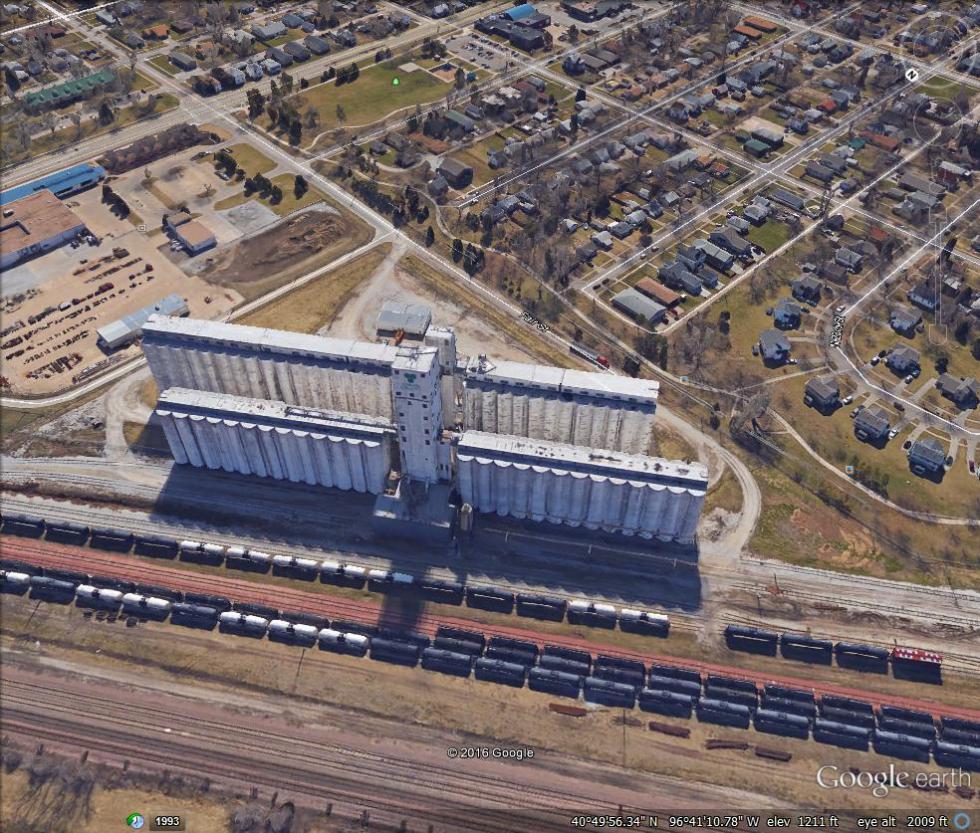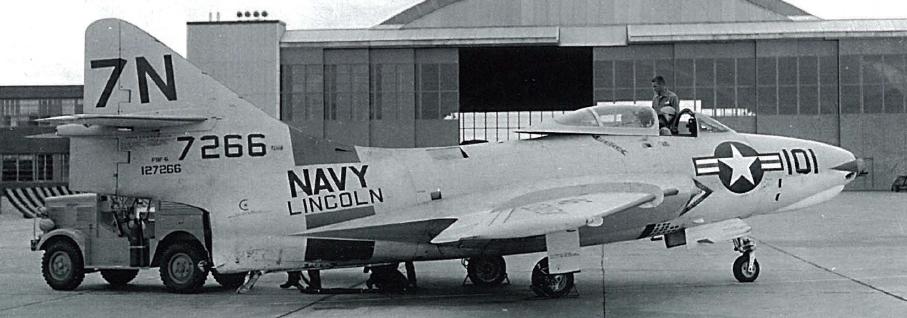Naval Air Station Lincoln
1948 - 1958



Above: First
Reserve Drill 1948 (Jim Dunlap): The first drill for NAS Lincoln, Nebraska was
held on December 15, 1948. Jim Dunlap, Photographers Mate (PM2C), is in the
second row, third from the left. Jim took many of the few remaining official
photographs for NAS Lincoln. Jim left the Navy in 1957 and enlisted in the
United States Air Force. His first duty station was the Lincoln Air Force Base
and continued taking official photographs until the base closed in 1966. Jim
retired as Master Sergeant in 1990. (Photo from Jim Dunlap collection, caption by Dave Thurber)
Origins of the Naval Air Station at the
Lincoln Air Force Base
Written By: Dave Thurber, USNR-Lincoln 1984-1990
Following the end of World War 2, the Navy Department reorganized the structure of the Naval Reserves and training across the United States. In the summer of 1946, the first naval reserve component authorized for Lincoln met at the former Lincoln Aviation Institute at 24th and “O” Streets. By 1948 the Naval Reserves had constructed a permanent training facility at 1625 N. 10th for surface fleet, medical, and Seabee detachments. Aviation personnel reported on December 15, 1948 to the newly designated Naval Air Station Lincoln (NAS) at one of the five former Lincoln Army Air Field hangers.
It was the need to continue training Naval pilots due to their call up for the Korean War and the development of the Lincoln Air Force Base for the Strategic Air Command that led to funding approval in September 1953 to construct a brand new $ 3 million dollar Naval Air Station on the east side of the runway. The new hanger would be patterned after the Naval Air Station at Buckley Field in Denver, Colorado. The new Lincoln Naval Air Station was dedicated on November 13, 1955 and was presented the Conway Trophy for 1955 as being the most proficient of the 28 Naval Air Reserve Stations. Final move in to the new facility was scheduled for January 1956 when a tragic aircraft accident occurred on December 18, 1955. A runaway F9F Cougar jet fighter crashed into and destroyed the existing hangar on the west side of the Lincoln Air Force Base sadly killing three Navy personnel. As a result, transition to the new hanger was completed ahead of schedule.
In the Department of the Navy Aeronautical Organization Plan for Fiscal Year 1957, NAS Lincoln was listed as being assigned to the 9th Naval District and having these units:
VA 761-Naval Attack Squadron
VF 761-Naval Fighter Squadron
VP 761,762-Naval Patrol Squadron
VR 761-Naval Air Transport Squadron
CV FASRON 761-Carrier fleet Aircraft Service Squadron
AAU 761,762,763-Auxiliary Air Units
AWS 76-Air Weather Service
VMF 113-Marine Fighter Squadron
The Marine Fighter Squadron, VMF 113 nicknamed the “Whistling Devils”
flying F4U-4 Corsairs, was a former World War 2 squadron activated in January
1943 and now part of the air training command.
Between 1946 to 1950, the Chief of Naval Operations issue several directives on the assignment of either one or two letters on the aircraft tail to identify squadrons and or stations. NAS Lincoln was assigned the letter B. The Chief of Naval Air Basic Training Command finally issued a directive on 6 Sept 56 that beginning in FY 1958, (1 July 57 ) all aircraft would have a two character alpha / numeric tail code. Naval Air Stations would all start with the number 7. NAS Lincoln aircraft would then be marked as 7B. Reserve aircraft would also have an orange ban painted on their fuselage until 1970.
By August 1957 rumors that the Lincoln NAS would be closing soon were confirmed to the City of Lincoln by Nebraska Senators Roman Hruska and Carl Curtis. The Department of the Navy reported that a realignment of bases due to a turn in the economy was the reason for several Naval Air Stations being decommissioned. There was also some indication that the focus on national defense was now on nuclear power. When the Lincoln Naval Air Station officially closed on February 1, 1958, the 749 Aviation Reservists, both Navy and Marine, would be transferred to the Olathe, Kansas NAS for drill weekends. The closure also impacted 278 permanent military personnel and 49 civilians at the Lincoln NAS. The Marine Squadron would make the transition from F4U-4 Corsairs to F9F Cougars when they were reassigned to NAS Olathe.
Although the Nebraska Air National Guard had just moved into their new hanger directly south of the Lincoln NAS in September 1956, they lobbied the Pentagon and moved into the vacant NAS facilities in March 1958. The Air National Guard hanger was then turned over to the Nebraska Army National Guard aviation unit which had been operating out of Camp Ashland.
Submitted by Dave Thurber, USNR-Lincoln, 1984-1990

1949
Inspection formation (Jim Dunlap): 1949 NAS Lincoln dress blues inspection
inside the hanger for Chief of Naval Air Reserve Training and Commander Marine
Air Reserve Training. (Caption by Dave Thurber)

Another angle of the previous event inside the South Hangar (Jim Dunlap Photo Collection)

The catastrophic 1955 NAS hangar fire, so hot the metal posts are melting. (Jim Dunlap Photo Collection)
Through the years the Naval Air Station operated the following aircraft:
- P2V Neptune Patrol Aircraft
- F8F Bearcat Fighters
- F4F Hellcat Fighters
- F4U Corsair Fighters
- F9F Cougar Jet Fighters
- TBF Avenger Torpedo Bomber Aircraft
- AD Skyraider Attack Aircraft

Hellcats over the prairie. Descended from the Wildcat fighter, Hellcats were the U.S. Navy's primary carrier-borne fighter plane later in the war. (Jim Dunlap Photo Collection)


A Lincoln P2V Neptune in flight over either the grain elevators by 6th and South or along Cornhusker Highway (let me know if you know which) (Jim Dunlap Photo Collection)
Below is the image today near 2400 Fair Street up along Cornhusker. (Thanks Dave Thurber for investigating this and sending the image!)


An F9F Cougar in flight, the type that replaced the F4U Corsairs. This was the same type that ran into the south hangar causing the fire. (Jim Dunlap Photo Collection)

From "Forgotten Jets"
(http://www.millionmonkeytheater.com/cougarpics/127266.jpg)
Combined Air Guard Operations
By early January 1949, the Nebraska Air National Guard stationed nearby worked with the Naval Air Reserve Station to unify some overlying operations. Shared facilities included a parachute loft, the gas farm, a Carburetor/Propeller Shop, a Battery Shop and a Carbon-Dioxide/Oxygen Transfer Shop. During the catastrophic Air Guard Fire of March 1949, Naval Reserve crews fought the blaze alongside Air Guard and Lincoln Fire units.
On 1 July 1949, a Marine Air Detachment joined the Naval Air Station and remained stationed there until the close in 1958.
Even by late 1950, Lincoln began to be of interest to the Strategic Air Command. During 1952, when the base was assured, Strategic Air Command asked that aside from the other tenants in Air Park that the Air Guard and Naval Air Reserve be moved and that the Air Force control effectively everything west of the runway.
Lincoln raced to secure funds for the National Guard, with the Army Guard departing for its present home on North 10th near the former Nebraska State Fair Grounds. Funding came through to construct a new hangar for the Air Guard while money was authorized for a new Naval Air Reserve hangar by September 1953.
Initially a 75 acre plot was requested for the new station but the congressional Armed Services Committee provided funds for 50 acres. A multi-purpose hangar, supply building, public works building, Half-million dollar fuel storage plant, heating plant, aircraft taxiway, apron and road paving, sewage and water facilities were funded and construction was soon underway.